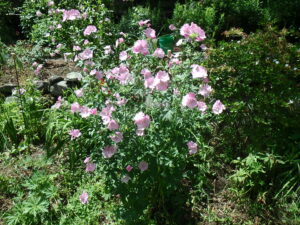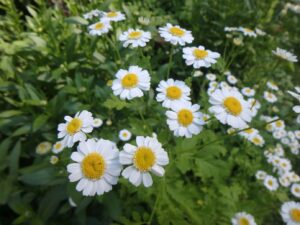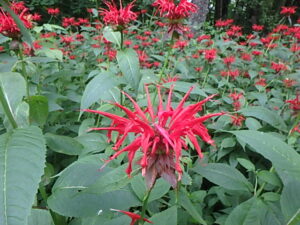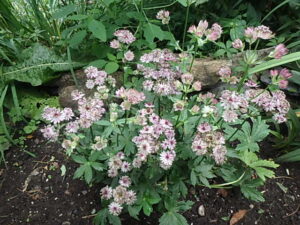Right Plant, Right Place: Tips for Growing Great Mid-Summer Flowers
Posted on Wednesday, July 8, 2020 · Leave a Comment
It is mid-summer now, and my garden is full of gorgeous flowers, some finishing up their display, others just beginning. Here are some I love, and what I do to make them happy.

This double poppy comes back every year in my vegetable garden
The first flowers I see when I walk out my front door are poppies. Annual poppies ( Papaver somniferum). I didn’t plant most of them, or not this year. Each year I let them bloom and drop seeds after they’re done. They reward me with dozens of blossoms the following year. Sometimes I pick the pods and save to sprinkle seeds on the snow, an easy way to plant them in the dead of winter.
My poppies are in full sun and soil that is not particularly rich. I like these poppies because they ask nothing of me and each year the palette is a little different as they hybridize, offering some new colors and sizes. I have a nice deep red double annual poppy that blooms every year in one row of my vegetable garden. This year it is with the tomatoes.

Pink mallow is an enthusiastic plant showing up everywhere
Another favorite of mine is pink mallow (Malva alcea). This is a big, often floppy perennial with lots of pink blossoms that resemble those of a hollyhock. In my garden it pops up anywhere and everywhere. I have to treat it a bit like a weed to keep it in control. It does best in full sun and rich soil that stays lightly moist.
Pink mallow has a tap root and does not transplant easily, unless you do so when small. I often stake mine to keep them upright – it can grow to be 2- to 5-feet tall. Not often seen in garden centers, get a seedling from a fellow gardener, and let it go to seed so you’ll get more plants.
Another flower that moves around the garden, appearing by

Feverfew volunteers to grow everywhere
whim, is feverfew ( Tanacetum parthenium). Feverfew has white daisy-like flowers with a yellow center, each blossom just three-quarters of an inch across, but appearing in vast numbers. It is a short-lived perennial that sows seeds freely, so if you don’t want more plants, cut off the flowers before the seeds are dropped.
Feverfew will grow in average soil, but prefers moist, rich soil. It’s blooming for me now, and will continue for the rest of the summer, or nearly. The flowers do well in a vase.
My beebalm ( Monarda didyma ) is just coming into full bloom now, and is deliciously fragrant. It is in the mint family, with a square stem that is relatively fragile. But they make great cut flowers, in part, because of their fragrance. Bees love them (hence the name), but hummingbirds do, too. Mine grow to 5 feet tall.

Bee balm does best in part sun and rich, moist soil
Many books claim beebalm is a full sun plant, but I disagree. It does best in morning sun or partial shade in rich, moist soil. It goes by quickly in hot, dry areas. The best blossom colors are red and purple, though cultivars in white and bluish are sold. Recently short varieties have appeared in the marketplace, but I have not found that they are very hardy. Beebalm spreads by root, but pulls easily if it gets too rambunctious.
Daylilies ( Hemerocallis spp.) are in bloom now, too. The common orange daylily is the friend of anyone who thinks they can’t grow flowers. You cannot kill a common orange daylily. I have dug them out, placed them on the lawn without any soil preparation, and they have thrived where placed.
Each blossom of a daylily blooms for just one day, but each scape, or flower stalk, has several buds that bloom in succession. The buds will open in a vase, too, so don’t be afraid to use them in flower arrangements. Unlike true lilies, these beauties are not eaten by lily-leaf beetles. They come in many colors from deep red to light yellow. I have tiny daylilies, and one variety that blooms on scapes as tall as me.

Astrantia does well in part sun
Great masterwort is an awkward name, so I prefer the scientific epithet, Astrantia major. This is a medium-height flower in the carrot family, along with Queen Anne’s lace, a wildflower or weed I love, too. The flowers range from white to purple-white, and bloom in great profusion. It is good cut flower, too. Each blossom is just an inch across, and resembles scabiosa.
Astrantia does well in part shade, but will grow in full sun if adequate moisture is present. The foliage is attractive even when the plant is not in bloom, and it is very well behaved – it stays as a nice clump and does not take over the garden.
I love knautia ( Knautia macedonia) both for the smallish (3/4-inch) purple-red, domed blossoms, and for its willingness to keep on blooming from now until fall. Most perennials have much shorter bloom periods, but knautia is a real trooper.
It has thin stems and delicate leaves, so is hard to display in a vase, but it is worth mixing with daisies or something else that will hold the blossoms up in a vase. I grow it in full sun with average soil, and it does well – and will occasionally provide volunteers from seed.
Each garden has its own winners and losers. Good gardeners try a lot of plants to find those that do best for them. So go buy some or trade with a friend.
Henry is a long time UNH Extension Service Master Gardener and the author of 4 gardening books. He is available for consultations near his home in Cornish Flat, NH.







